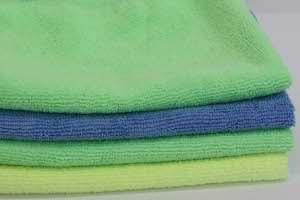Cleaning with Microfiber Cloth
by: Dale Cox

If you haven't heard yet, microfiber is truly a revolution in cleaning products. This material has a microscopic structure that literally scoops up dirt particles, oil, grease, liquids, and even bacteria to leave a clean not possible in the past. Materials like cotton, long used for cleaning most surfaces, will pass right over particles that microfiber grabs and holds for superior results when dusting, polishing, and cleaning all types of hard surfaces.
Check here for a Streak-Free Window Cleaning Video
Cleaning Wood Window Blinds Video
Cleaning Hardwood Floors Video
In addition to its exceptional cleaning ability, microfiber is very soft and lint free, making it perfect for cleaning surfaces like glass, tile, flat screens, and auto paint. As an added advantage, there's no need for chemical cleaning product when using microfiber. All these surfaces can be cleaned to a completely streak-free finish with just a bit of water. For dusting, microfiber can't be beat. Because it tends to become statically charged, it attracts dust and then holds it in the fibers until rinsed out. And microfiber is very absorbent, holding about 8 times its weight in liquid, making it great for cleaning up spills and drying everything from hair, to dishes, to dogs, to cars.
About Microfiber
Microfiber is the combination of two synthetics: polyester and nylon, also know as polyamide. To make cleaning products, the resulting fibers are split to create the structure pictured here. This structure is what makes microfiber such a great cleaning tool. Because the thread is so small, about 1/100th the diameter of a human hair, it is able to grab microscopic particles that other cloth simply can't because they are much larger and pass right over tiny particles.
Microfiber was first created in the 1950's but it wasn't until the 70's a fiber was developed that could be used to manufacture textiles. Since then microfiber has been used to make clothing, furniture upholstery, wallets and handbags, tablecloths, and cleaning products. Cleaning results, in particular, have been simplified and improved greatly due to the development of microfiber. Microfiber can be used for dusting, polishing, removing grease and oils, mopping floors, cleaning tile and glass, and auto detailing.
Household Uses for Microfiber
- Dusting: Probably the best use for microfiber is dusting. All other dusting rags, mops, etc. will collect some dust but will inevitably just spread it around soon after you've begun. Not so with microfiber, it will collect and hold ALL the dust found on a surface. Just fold it over a couple time and flip the cloth to a clean spot as it becomes filled with dust. Wash the cloth when you're done.
- Drying: For drying nothing beats microfiber. It holds a lot of liquid and works great as a dish towel, a car shammy, a hair towel, and for drying and cleaning a wet dog, horse, etc. It can replace paper towels in the kitchen and shop, being more effective at wiping and drying counters and cabinets while also being environmentally friendly.
- Polishing: Because microfiber is so soft, it works great for polishing all kinds of surfaces. Try it on your silver and brass. For your car nothing works better. Make sure the surface is free of grit, as the microfiber will grab and hold tiny particles that can scratch the surface you're trying to polish.
- Cleaning Windows: Cleaning windows has never been simpler or easier. Use two microfiber cloths, one dry and the other saturated with clean water. Wring out the excess water and use the wet one to completely wipe down the glass. Follow immediately with the dry cloth to polish the glass for streak free windows and mirrors.
- Mopping: Microfiber may be the best thing that every happened to floor mopping chores. Using just a mist of water and a microfiber mop, you can get the cleanest hardwood and tile floors you've every seen. And because microfiber removes bacteria as well as dirt, your floors will be more sanitary as well.
- Electronics: For cleaning flat screens on TV's, computers, smartphones, and tablets you should never use anything but microfiber. Many electronics manufacturers will recommend and often supply a microfiber cloth for keeping these high tech devices looking and working great. Check here for tips and techniques to clean all the flat screens in your life.
Caring for Microfiber
- Wash Separately: Washing with other fabrics will reduce microfiber's effectiveness as it collects lint, dyes, and debris from anything you wash with it.
- Stockpile Dirty Microfiber: It's best to keep a supply of cloths and collect them as they get used so you can wash them all together. It also good to switch them out as you clean to avoid scratching surfaces as the cloth collects grit.
- Use Minimal Detergent: It's best to use as little detergent as possible to keep microfiber at its best. Choose a liquid detergent free of dyes and perfumes to avoid clogging the fibers or use a specially made detergent intended for microfiber. Before washing, rinse and wring out dirty cloths several times in a small pail of clean water until no more dirt is released. Don't dry. Immediately submerge the damp cloths in a bucket of clean water and let them soak for a couple hours before machine washing.
- No Fabric Softener: Don't use fabric softener in the washer or dryer. It will clog the fibers and prevent the cloth from collecting anything else.
- No Bleach: It will degrade the fibers and make the cloth less absorbent and not as soft.
- Avoid Heat: To avoid heat damage use cool to lukewarm water for washing. Line dry or use a no-heat fluff cycle to machine dry.
- Never Iron: To avoid heat damage, never press microfiber with an iron, it will melt the synthetic fibers.
- About Vinegar: You don't need vinegar to clean with microfiber and the acid content may damage the cloth over time.